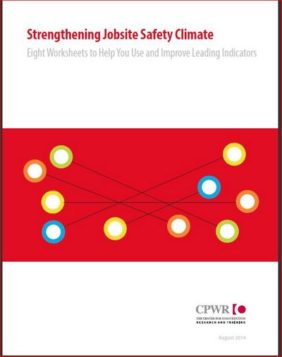By Mary Watters and Linda Goldenhar, Ph.D.
If a superintendent starts with a safety talk in the morning, but focuses only on production the rest of the day, foremen and workers may start to think it’s acceptable to cut corners on safety to get the job done. A good safety climate requires integrating safety concerns into every aspect of a firm’s operations. But how is that best accomplished?
Leaders in the construction industry are well aware of costs associated with work-related injuries and illnesses. Yet many firms remain overly dependent on lagging indicators (injury numbers and rates) to identify needed safety improvements. The problem: lagging indicators do not help companies learn how to prevent injuries and illnesses before they occur.
Researchers at CPWR—The Center for Construction Research and Training—began exploring the use of leading indicators. A leading indicator refers to activities that, when properly implemented, prevent and control injuries and illnesses.
To better understand these issues, CPWR gathered construction industry stakeholders from business, labor, academia and government to participate in a two-day workshop. As a group, they created construction-specific definitions of “safety culture” and “safety climate,” and reliable and valid ways to measure the concepts. The group identified eight leading indicators that can influence jobsite safety climate:
- Supervisory leadership
- Safety as a value/safety alignment
- Management commitment
- Employee empowerment and involvement
- Accountability
- Communication
- Training
- Owner/client involvement
As an example, participants discussed essential and practical ways that activities related to “supervisory leadership” could be implemented in the real world. Some of these activities include : Leads by Example — Is a role model for safety, “Walks the Talk,” Encourages Innovation, Is a Coach, Motivates Others, and Performance Evaluations that focus primarily on being a good safety leader.
A number of the interventions, including planning for safety, came up across several factors and are worth discussing a bit more. By including safety early in the planning process, safety climate and safety-related outcomes are likely to improve. The workshop participants recommended including safety in the design phase, in the bid specifications, in production and planning meetings, in pre-task planning and even in pre-job meetings with the owners.
Another cross-cutting leading indicator identified was the need to create a continuous learning environment and provide ongoing training and education for individuals at all levels. The types of training recommended included: empowerment training for workers; leadership education for supervisors, including communication, listening and coaching skills; training for senior management to understand how safety fits in to and affects quality and production, and their own critical role in leading the safety effort; joint safety committee training and training in safety interventions.
 Of course, these are great ideas, but barriers can arise. You can read more in Chapter 4 of the report, Safety Culture and Climate in Construction: Bridging the Gap Between Research and Practice.
Of course, these are great ideas, but barriers can arise. You can read more in Chapter 4 of the report, Safety Culture and Climate in Construction: Bridging the Gap Between Research and Practice.
The interventions, plus more ideas for improving the eight leading indicators identified in the workshop, are included in a practical 10-page workbook that safety professionals and management can use to improve safety climate on their construction sites.
That workbook, Strengthening Jobsite Safety Climate, contains eight worksheets; each offers a quick self-assessment for leading indicators of safety climate. That is followed by a list of ideas that owners, contractors, safety directors and supervisory staff can implement to evaluate and improve their safety climate. The ideas range from including safety in company mission statements and holding daily huddles to using suggestion boxes on the jobsite and implementing near-miss reporting systems.
The workbook and workshop report are available for free download on the CPWR website. Print editions are available while supplies last by contacting news@cpwr.com.
The research and publications documented in this article were supported by Grant OH009762 from The National Institute for Occupational Safety and Health (NIOSH). The contents are solely the responsibility of the authors and do not necessarily represent the official views of NIOSH.



 Join our thriving community of 70,000+ superintendents and trade professionals on LinkedIn!
Join our thriving community of 70,000+ superintendents and trade professionals on LinkedIn! Search our job board for your next opportunity, or post an opening within your company.
Search our job board for your next opportunity, or post an opening within your company. Subscribe to our monthly
Construction Superintendent eNewsletter and stay current.
Subscribe to our monthly
Construction Superintendent eNewsletter and stay current.